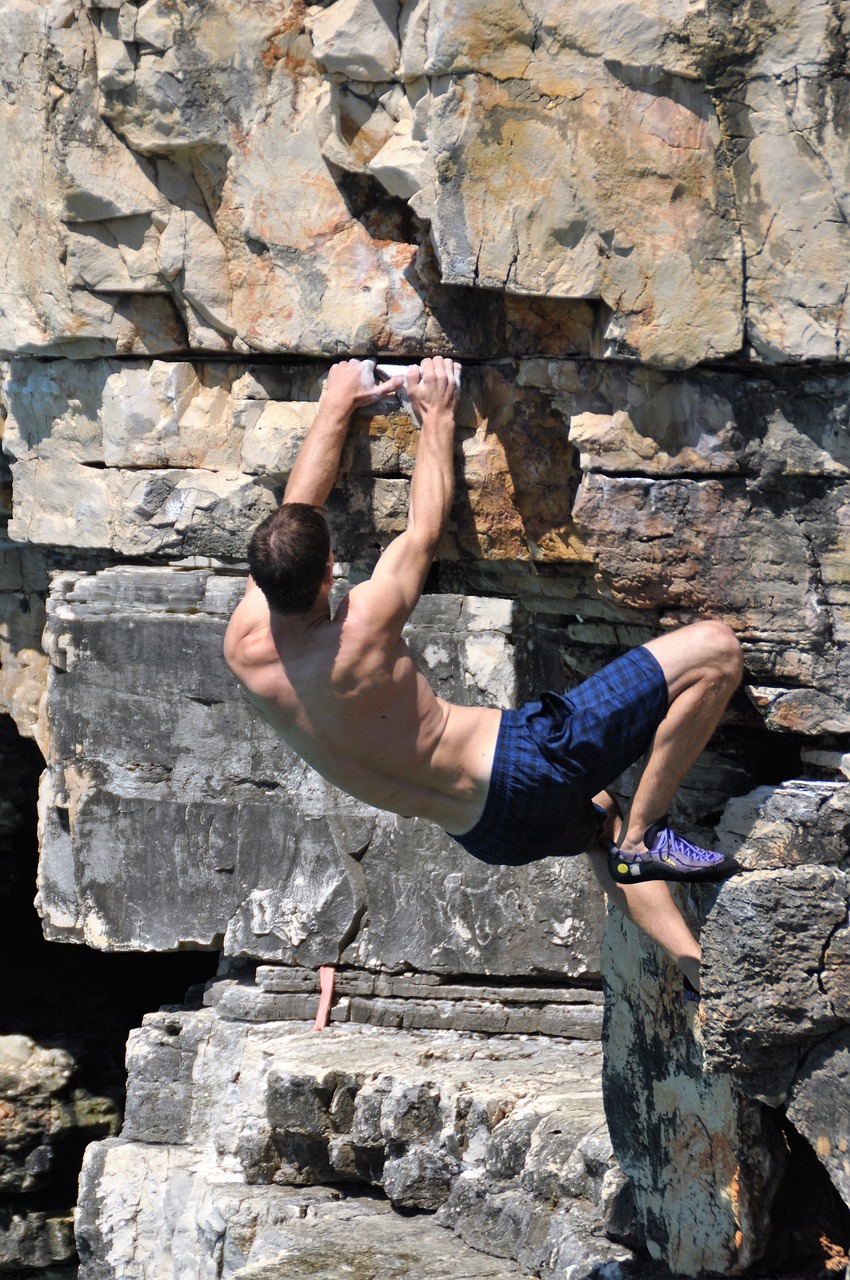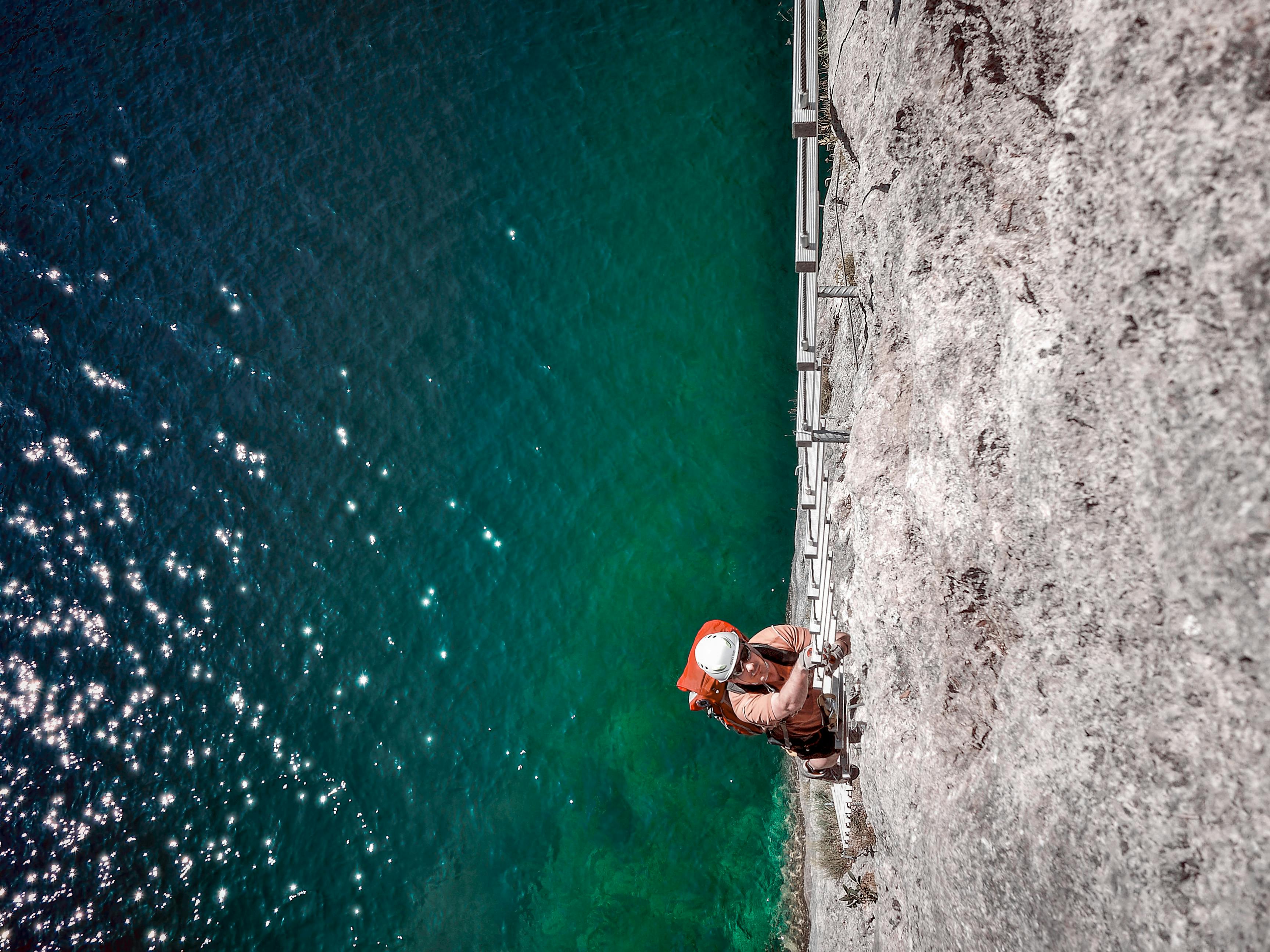What To Wear Rock Climbing

Rock climbing is an exciting and challenging sport. It can take you to beautiful places and be a great way to get an adrenaline rush. But before you can climb, you need to make sure you have the right clothes for the job. Knowing what to wear rock climbing can be a challenge, but if you plan ahead and dress appropriately, it will make your experience much more enjoyable. In this article, we will discuss the fundamentals of what to wear rock climbing so that you are comfortable and safe while scaling those rock walls or cliffs.When rock climbing, it is important to wear the right clothing. Loose-fitting, comfortable clothes are best for climbing, such as shorts or stretchy pants, a lightweight t-shirt or tank top, and a light hoodie or jacket. Make sure your clothing does not restrict your movement and does not get in the way of any of the equipment you may be using. Additionally, wear shoes that provide good grip and support on the rocks; avoid shoes with smooth soles. Finally, consider wearing a helmet to protect your head from any falling rocks or slips during the climb.
What Shoes To Wear For Rock Climbing
When it comes to rock climbing, choosing the right shoes can be the difference between a successful climb and an unsuccessful one. The right pair of shoes will not only provide a secure foothold but also enable you to move more freely and efficiently up the rock face. The type of shoe you choose will depend on the type of climbing you’re doing, but there are some general guidelines to follow when choosing rock climbing shoes.
To ensure that your feet are properly supported, look for a shoe with stiffer soles and good cushioning. A stiffer sole will give you better support when pushing off from holds and standing on small edges. Look for shoes with rubber soles that provide good grip and traction on all types of terrain. Some shoes may also come with extra features such as toe caps for extra protection or reinforced heel cups for added stability.
When it comes to fit, it’s important to get the right size and shape for your feet. Shoes that fit too tightly can cause blisters or other foot injuries while shoes that are too loose can make it harder to maintain balance on the wall. Make sure there’s enough room in the toe box so your toes aren’t cramped but not so much room that your foot slides around in the shoe. Your heel should fit snugly in the back without slipping out when you move around on the wall.
Finally, think about what type of terrain you’ll be climbing on and what kind of support and protection your feet need in those conditions. For overhanging routes or rocky terrain, look for thicker rubber soles with more cushioning; for technical routes or slabs, look for thinner rubber soles that will enable more flexibility and sensitivity on small edges.
Finding the right pair of shoes is essential for any rock climber – with the right pair, you’ll have better control over your movements and a much more successful climbing experience!
Dress Appropriately For Rock Climbing
When it comes to rock climbing, the right clothing can mean the difference between a successful climb and hours of frustration. The right clothing will not only help you stay comfortable and protected while climbing, but also help you look stylish and feel confident. Whether you’re a beginner or an experienced climber, here are some tips on how to dress appropriately for rock climbing.
First and foremost, wear clothes that fit properly. Tight-fitting clothes can make it difficult to move around freely, while loose-fitting clothes can get in the way or even snag on rough surfaces. Choose lightweight fabrics such as cotton, nylon, or spandex that provide a good range of motion. Also consider wearing layers so that you can adjust your clothing easily depending on the temperature outside.
Second, make sure your shoes are appropriate for rock climbing. You want footwear that provides enough grip and support to keep you stable while climbing. Look for shoes with thick soles and rubber treads that won’t slip on wet or slippery surfaces. Many climbers prefer shoes with laces so that they can adjust the fit as needed during their climb.
Third, don’t forget safety gear such as helmets and harnesses when going out to climb rocks. Helmets are essential for protecting your head from falling objects or debris while harnesses help keep you secure in case of a fall. Make sure all your safety gear fits properly and is designed for rock climbing specifically before heading out on a climb.
Finally, don’t forget to accessorize! Sunglasses are great for keeping the sun out of your eyes while hats help keep sweat from dripping into them. Gloves will also help protect your hands from scrapes and scratches while climbing. And if you need something to store all your gear in, invest in a sturdy backpack that won’t get in the way of your movements or weigh you down too much when you reach higher levels of the climb.
These tips will help ensure that you have an enjoyable time rock climbing by staying comfortable and safe throughout your adventure!
What Accessories To Wear For Rock Climbing?
When it comes to rock climbing, the most important thing you need are the right accessories. To ensure a safe and enjoyable experience, it is essential that you have the right clothing and gear. The following are some of the accessories you should consider when preparing for your next climb:
Helmet: A helmet is essential for any type of climbing, including rock climbing. It will protect your head from falling rocks and debris that could otherwise cause serious injury or even death. Make sure to choose a helmet that fits properly and has an adjustable chin strap so you can secure it in place.
Harness: A harness is necessary to keep you securely attached to the wall as you climb. Look for a harness that is comfortable but also provides adequate support for your body weight. It should also have adjustable leg loops so you can adjust it according to your size.
Climbing Shoes: Climbing shoes are specially designed to provide grip and support when climbing on rock surfaces. They usually feature sticky rubber soles that help keep your feet firmly planted on the wall as you make your way up or down. Make sure they fit correctly so they don’t slip off during your ascent.
Chalk Bag: Chalk bags are used to store chalk, which helps increase friction between hands and feet while climbing. Chalk bags come in various shapes and sizes, so make sure to choose one that fits comfortably around your waist or shoulder without being too bulky.
Climbing Rope: A rope is necessary for any type of rock climbing, whether indoor or outdoor. It helps keep you securely attached to the wall while also providing an anchor point in case of a fall or emergency situation. Make sure the rope is rated correctly for the type of climb you’re doing and inspect it before each use for any signs of wear and tear.
These are just some of the basic accessories every climber should consider when preparing for their next adventure in rock climbing. With these items in hand, you’ll be ready to tackle any challenge with confidence!
Important Clothing Items For Rock Climbing
Rock climbing is an incredibly rewarding sport, but it does come with a few risks. Knowing what to wear and how to dress appropriately for the activity is essential for keeping safe and comfortable. Having the right clothing items for rock climbing is important, as it can protect you from the elements, allow you to move more freely, and provide support when necessary. Here are some of the most important clothing items for rock climbing:
First and foremost, having a good pair of shoes is essential. Shoes that are specifically designed for rock climbing have extra grip on the soles, which helps you better handle the rocks. They also have extra padding in the toes and heel, which helps reduce shock from long hours of standing on hard surfaces. Additionally, look for shoes that are lightweight and breathable to keep your feet cool.
Next up is clothing that provides flexibility and mobility while climbing. Look for clothes that are made out of lightweight materials like nylon or Spandex as these will allow you to move freely without getting too hot or uncomfortable. Avoid bulky items like jeans or thick sweaters as they can limit your range of motion when scaling rocks.
Finally, consider investing in a crash pad if you plan on doing any bouldering (climbing without ropes). Crash pads provide cushioning in case of a fall so you don’t injure yourself on landing. Additionally, they also provide insulation from cold surfaces so your feet don’t get too cold during longer climbs.
By taking the time to properly research and invest in the right clothing items for rock climbing, you’ll be able to ensure your safety and comfort while out on your next adventure. So don’t skimp on quality – it could be the difference between success and failure!

Safety Gear Required For Rock Climbing
Rock climbing is a thrilling and adventurous sport that requires significant safety measures. Safety gear is an essential part of rock climbing and should never be overlooked. Proper safety gear helps to protect climbers from serious injuries in the event of a fall or other accident. The most important pieces of safety gear for rock climbing include a helmet, harness, carabiners, dynamic rope, static rope, slings, quickdraws, belay device, and chalk bag.
A helmet is the most important piece of safety gear for rock climbing and should always be worn when climbing. Helmets provide protection from head injuries that can occur in the event of a fall or when rocks or other debris falls from above. Climbing helmets are designed specifically for rock climbing and should fit snugly on the head to provide maximum protection.
A harness is an adjustable belt that is worn around the waist and legs to provide support while climbing. It allows climbers to attach themselves to anchors on the wall and securely clip into ropes so they can safely rappel down after completing their climb. Climbing harnesses come in different styles depending on the type of activity being done and should always fit properly in order to be effective.
Carabiners are metal loops with a spring-loaded gate that are used to connect pieces of safety equipment together such as ropes and slings. They come in many shapes and sizes with varying degrees of strength so it’s important to choose the right carabiner for each situation.
Dynamic rope is designed specifically for rock climbing and should be used instead of standard utility rope which can easily break under stress or stretch too much upon impact causing injuries or worse. Dynamic rope provides enough elasticity to absorb shock when taking falls while still providing enough strength to hold your weight securely.
Static ropes are designed for rappelling or ascending fixed lines, but they can also be used as anchor points when setting up top-rope systems or belay systems. Static ropes are not as elastic as dynamic rope so they don’t provide as much shock absorption but they do provide more security than standard utility rope which makes them ideal for certain situations where extra security is needed such as big wall climbs or multi-pitch climbs where there may not be any natural protection points available for anchoring your system safely.
Slings are long straps that can be used to extend anchors or create a more secure anchor system by linking multiple pieces together into one solid anchor point . Slings also come in different lengths so it’s important to choose one that fits your needs appropriately.
Quickdraws are two carabiners connected by a short sling with one end attached to an anchor point on the wall while the other end attaches directly onto your harness . Having multiple quickdraws allows you to quickly move up a route without having to reattach yourself every time you want to move up higher on the wall . Quickdraws come in different lengths depending on how far apart you need your carabiners spaced .
Belay devices are specialized tools used for controlling the descent speed of climbers when rappelling down after completing their climb . Belay devices come in several different designs depending on what type of activity you’re doing but all require proper instruction before use .
Finally, chalk bags contain blocks of powdered chalk which helps keep hands dry during sweaty climbs . Chalk also helps grip holds better making it easier (and safer) for climbers when attempting difficult moves . Chalk bags typically include a belt so they can be easily attached around your waist while climbing .
In conclusion , these pieces of safety gear will help protect climbers from serious injury while out adventuring on some exciting routes!
Clothing Items To Avoid When Rock Climbing
Choosing the right clothes for rock climbing is essential to your safety and comfort. Knowing the clothing items to avoid when rock climbing is just as important. It is important to keep in mind that certain clothing items can be hazardous and reduce your mobility, making it difficult to climb safely. Here are some of the clothing items you should avoid when rock climbing:
Loose-fitting clothing: Loose-fitting clothes can get caught on rocks or other objects while you are climbing, making it difficult to move around safely. It is best to wear fitted clothes such as leggings or shorts that won’t hinder your movement.
Jewelry: Jewelry can be dangerous when rock climbing as it can get caught on rocks and equipment, potentially causing injury. It is best to leave all jewelry at home before going out rock climbing.
Flip-flops: Flip-flops offer little support and can easily slip off, leaving you vulnerable during a climb. Wear sturdy shoes that offer good grip and support while you are climbing.
Baggy Shirts: Baggy shirts can be a hazard when rock climbing as they can get caught on equipment or rocks, making it difficult for you to climb safely. Wear fitted tops that won’t hinder your movements while you are scaling a wall or cliff face.
Fabrics That Don’t Breathe: Choose fabrics that are breathable so that your skin doesn’t become too hot or sweaty during a climb. Fabrics such as cotton are ideal as they allow air to circulate around the body and help keep you cool during a climb.
It is important to remember these clothing items to avoid when rock climbing in order to stay safe and comfortable while scaling walls or cliff faces. Choose the right clothes for rock climbing so that you can enjoy your adventure without any worries!
Layering Clothes For Maximum Comfort In Rock Climbing
Layering clothes is essential when rock climbing, as it helps keep you comfortable in different temperatures and weather conditions. Proper layering can also help protect you from the sun’s harmful UV rays, wind, and even rain. The key to successful layering is to choose lightweight materials that wick away moisture so that you stay dry and sweat-free. Additionally, you should try to layer your clothing in such a way that it allows for easy movement while still providing the necessary coverage.
The first layer should be made of synthetic fabrics such as polyester or nylon, as these materials are breathable and will help to wick away moisture. A long-sleeved shirt or lightweight jacket should be worn over this base layer for extra coverage and warmth. For cooler climates, a fleece pullover or vest can be added for additional insulation.
The second and third layers should be made of natural fibers such as wool or cotton, as these materials will provide warmth without adding too much bulk. A light wool sweater or cotton t-shirt can be worn over the first layer for added warmth. If you expect colder temperatures or rain during your climb, consider wearing a waterproof shell jacket over this layer.
The fourth layer is usually an outer shell designed to protect against wind and rain. This could include a lightweight windbreaker or a waterproof rain jacket with a hood. It’s important to choose a jacket with breathable fabric so that sweat isn’t trapped underneath it and make sure that the fit is loose enough to allow for full range of motion while climbing.
Finally, accessories such as hats, gloves, scarves, and even gaiters can be added depending on the weather conditions. These items can help keep you warm in cold climates and provide extra protection from the elements while climbing outdoors.
By layering clothes properly when rock climbing, you can ensure maximum comfort in all kinds of weather conditions while still allowing for unrestricted movement on the rock face. Choose lightweight fabrics that wick away moisture while providing necessary coverage and protection against adverse weather conditions so that you can focus on your climb safely and comfortably!

Conclusion
When it comes to choosing the right clothing for rock climbing, the most important thing is to be comfortable and protected. The right clothing will enable you to move freely and protect you from scrapes, cuts, and abrasions. Choose clothing that is made from breathable, lightweight fabrics with plenty of pockets for storage. Make sure you wear layers depending on the weather. Wear full-length pants or shorts, a long-sleeved shirt, and a good pair of shoes with good grip. A hat, sunglasses, and gloves are also important to protect you from the elements. With the right clothing choices, you can stay safe and enjoy your rock climbing experience!
